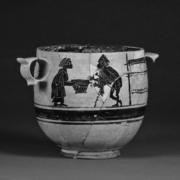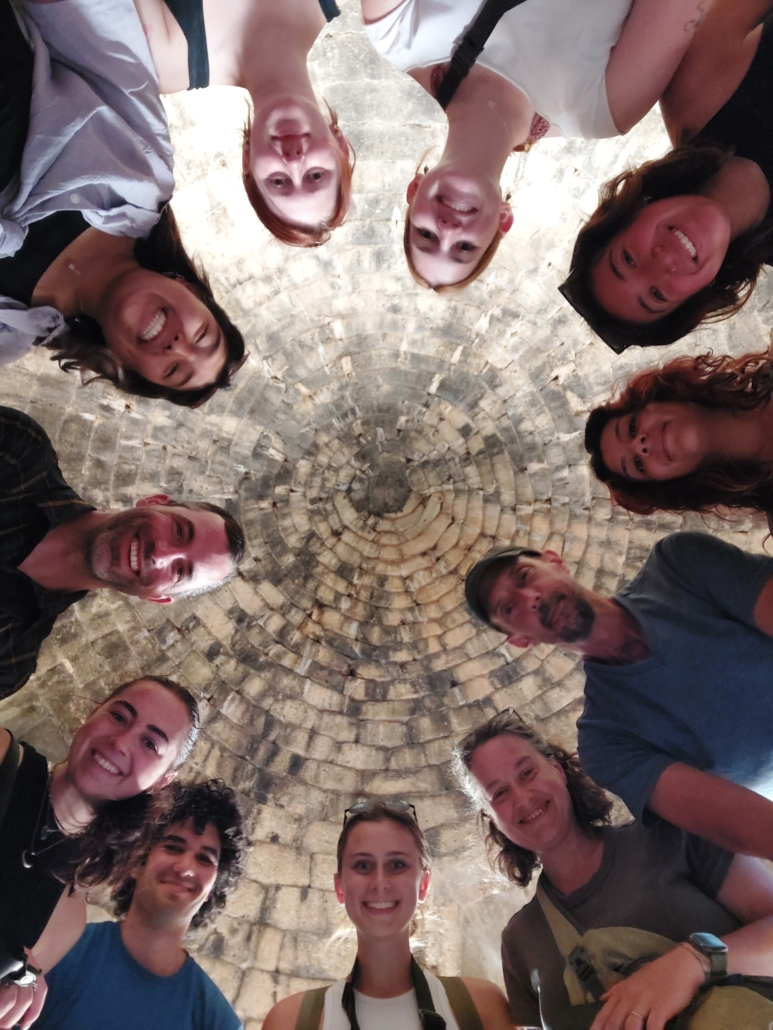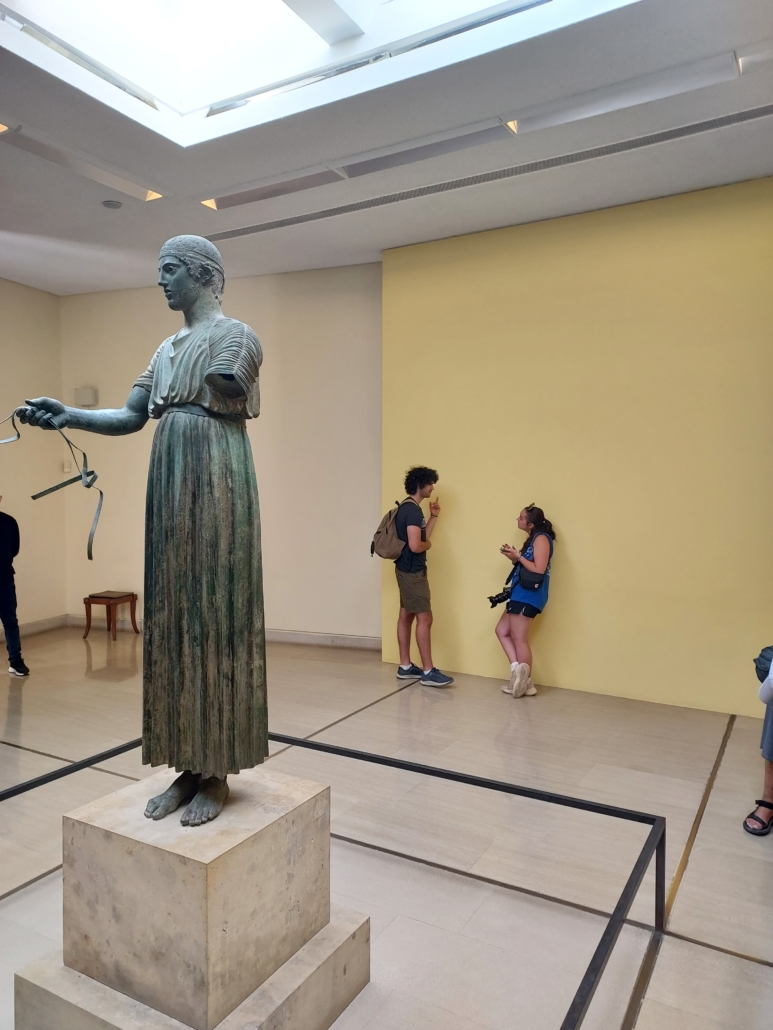Collective
Vanessa Fernendez
Red earthenware, white and marbled stoneware, cotton, wood, metal
 Although my time in Greece was wonderful, every new experience was accompanied by feelings of melancholy and guilt. I had so many adventures, but they were possible only because people back home gave their time and energy to cover my usual responsibilities. I feel that my place is at home with my family. My job is to care for everyone and everything, regardless of the personal cost. Nevertheless, I tried to collect small moments for myself. The raspy feeling in the back of my throat after a long hike. Seeing the Parthenon from a distance in the night sky. I am learning to take these small moments and keep them for myself. I am not able to separate the guilt from the joy but I am collecting them regardless—like the pebbles that make a sound when the waves wash over them at the beach.
Although my time in Greece was wonderful, every new experience was accompanied by feelings of melancholy and guilt. I had so many adventures, but they were possible only because people back home gave their time and energy to cover my usual responsibilities. I feel that my place is at home with my family. My job is to care for everyone and everything, regardless of the personal cost. Nevertheless, I tried to collect small moments for myself. The raspy feeling in the back of my throat after a long hike. Seeing the Parthenon from a distance in the night sky. I am learning to take these small moments and keep them for myself. I am not able to separate the guilt from the joy but I am collecting them regardless—like the pebbles that make a sound when the waves wash over them at the beach.
My piece consists of individually formed ‘pebbles’ that together are equal to my weight in clay. They are a representation of the little moments of joy that I collect for myself. They sit upon a dining table, which for me represents the collective identity of family. Individually, each pebble is small and light but together they weigh down the cloth to reveal the deep tension between joy and guilt.
Realized Myths
Paulette Gutierrez
Red earthenware, wire
 The silphium plant, renowned in antiquity for its myriad uses, was driven to extinction due to its demand as an abortifacient. It has been dubbed the “love plant” because of its connection with intimacy and the appearance of its fruit, which resembled a heart. But this positive connotation overshadows its critical role for women in dire circumstances. As ancient as the silphium plant is the normalization of sexual violence towards women. Greek mythology is rife with tales of sexual assault, with gods assuming various forms to approach their victims unguarded: Zeus as golden rain, a bull, or a swan; Poseidon as a horse. Such stories were so common that they were even depicted on everyday objects. For instance, a common design for an oil lamp shows Zeus as a swan with Leda.
The silphium plant, renowned in antiquity for its myriad uses, was driven to extinction due to its demand as an abortifacient. It has been dubbed the “love plant” because of its connection with intimacy and the appearance of its fruit, which resembled a heart. But this positive connotation overshadows its critical role for women in dire circumstances. As ancient as the silphium plant is the normalization of sexual violence towards women. Greek mythology is rife with tales of sexual assault, with gods assuming various forms to approach their victims unguarded: Zeus as golden rain, a bull, or a swan; Poseidon as a horse. Such stories were so common that they were even depicted on everyday objects. For instance, a common design for an oil lamp shows Zeus as a swan with Leda.
My study abroad experience led me to recognize the similarities between women in antiquity and today. Women in both ancient Greece and contemporary times have felt the desperation of being denied access to abortions—whether that be by the extinction of silphium or through restrictive laws. My ceramic sculpture of a silphium plant incorporates the iconography from famous Greek myths to highlight the ongoing importance of women’s reproductive rights against the backdrop of sexual violence. This project emphasizes the persistent struggles women face across time and contemplates an extinction of the traditions that keep such oppressions in place.
Eternal Moments
Avery Horejsi
Porcelain, ceramic decal
 My ceramics project encapsulates the essence of a transformative journey through the heart of Greece. Consisting of nine photographs printed on ceramic decals and applied to porcelain, this work celebrates the candid, intimate moments that define our experiences.
My ceramics project encapsulates the essence of a transformative journey through the heart of Greece. Consisting of nine photographs printed on ceramic decals and applied to porcelain, this work celebrates the candid, intimate moments that define our experiences.
Each photograph captures the spontaneity and authenticity of the trip while also reflecting the richness of our interactions—whether it’s the camaraderie shared with peers, the wisdom imparted by mentors, or the solitary contemplation of Greece’s breathtaking landscapes. Through these snapshots, I aimed to freeze in time the fleeting yet profound connections we made, both with each other and with the environment around us.
The porcelain medium serves as a perfect canvas for these memories, its delicate yet resilient nature mirroring the fragile beauty of the moments we experienced. The ceramic decals add a layer of permanence to the otherwise transient, allowing us to revisit these memories time and again.
This project allowed me to pay tribute to the intimacy and depth of human connections forged in a place of immense beauty and historical significance. I invite you to pause and appreciate the subtle, often overlooked moments that shape our journeys and leave an indelible mark on our lives.
(Thanks to Daniel Trego for introducing me to the world of photography and for pushing and challenging me every day.)
Divine Solitude
Gabe Jones
White stoneware
 During my study abroad experience in Greece, I was deeply moved by the faithful lives of the Greek Orthodox monks. Their unwavering commitment to God and spiritual devotion left a lasting mark on both my artistic journey and personal faith.
During my study abroad experience in Greece, I was deeply moved by the faithful lives of the Greek Orthodox monks. Their unwavering commitment to God and spiritual devotion left a lasting mark on both my artistic journey and personal faith.
My contribution to the exhibition is a tribute to these individuals, honoring their dedication to God and their profound influence on my creative expression. The form I created reflects the simplicity found in the monastic life. Inspired by the monks who dedicate themselves to quiet contemplation and humble service, this form embodies the essence of their tranquility and undemanding beauty. Its minimalist body and tones evoke the peacefulness of monastic environments. I aim to capture the essence of spiritual devotion and the timeless elegance of a life lived in simplicity and mindfulness. Through their example, I will continue exploring the intersection of spirituality and art, seeking to display the spiritual truths that resonate universally.
Pace of Life
Jillian Moreno
White stoneware, wood
 While in Greece, I experienced time differently. The days seemed longer. I felt present in the moment. I did not check the time constantly in expectation of the next event. Though this feeling could be the result of new and exciting experiences, I found Greece to have something special I have not experienced before. The culture around me was very relaxed and leisurely, which led me to realize how rushed my life in America has become.
While in Greece, I experienced time differently. The days seemed longer. I felt present in the moment. I did not check the time constantly in expectation of the next event. Though this feeling could be the result of new and exciting experiences, I found Greece to have something special I have not experienced before. The culture around me was very relaxed and leisurely, which led me to realize how rushed my life in America has become.
My understanding of time while in Greece is represented on the surface of the vessels I have created for this exhibition. While forming a cylinder on a wheel, rings naturally form on the surface of the clay as it grows taller. Working at the correct speed creates even and straight rings, but if you rush the process, the rings become slanted and uneven. These trace marks of rushed or leisurely time are then fired into the surface to be seen by all who take the time to notice.
The lines on my cylinders are a meditation on my internal and external experiences of time. Encoded into these rings are emotions, which played an important role in my perceptions of time. Stress, joy, peace, and uncertainty are represented on my cylinders. I am left to wonder—in what ways do we all carry such signs of the pace of our lives?
Interwoven
Shaylyn Sprague
Red earthenware, wood, metal
 The Goddess Circe is commonly depicted as a witch, who, in various versions of the myth acted out of revenge and envy towards mortals and even other gods and nymphs. According to Ovid, in a fit of jealousy over Glaucus, she turns her rival Scylla into a monster. In Homer’s Odyssey, she turns the hero’s crew into swine. But these are stories told from men’s perspectives.
The Goddess Circe is commonly depicted as a witch, who, in various versions of the myth acted out of revenge and envy towards mortals and even other gods and nymphs. According to Ovid, in a fit of jealousy over Glaucus, she turns her rival Scylla into a monster. In Homer’s Odyssey, she turns the hero’s crew into swine. But these are stories told from men’s perspectives.
My study of the treatment of women in ancient Greek mythology and society has given me the drive to create a retelling of Circe’s story. Inspired by the style of ancient black figure vases and following the timeline of Madeline Miller’s retelling of Circe’s adventures, I illustrate a story from a woman’s point of view in a world where even goddesses are not free from stories rooted in misogyny. Where in the ancient myths Circe is depicted as evil and only fueled by emotions of jealousy, Miller’s version focuses on one woman’s desire to be a part of a community. In this retelling, Circe’s motives are misunderstood–she is driven by a desire for connection and involvement. In Glaucus and Odysseus, she seeks a partner, not a victim. Yet, in the end, she is left alone, while these heroes are rewarded with kingdoms.
Lost History
Hunter Thomas
White stoneware, red earthenware, sand
 Lost History touches on the displacement of Greek citizens from their homes in response to the excavation of ancient relics on their property. The unjust seizure and destruction of neighborhoods has caused a mass population shift and erasure of interwar architecture, leaving many to wonder when ancient histories will finally cease to outweigh contemporary ones.
Lost History touches on the displacement of Greek citizens from their homes in response to the excavation of ancient relics on their property. The unjust seizure and destruction of neighborhoods has caused a mass population shift and erasure of interwar architecture, leaving many to wonder when ancient histories will finally cease to outweigh contemporary ones.
Group Workshop Project
Valsamakis Studio
Stoneware tiles, wood
 Located in the northern suburbs of Athens, Valsamakis Ceramics is the last traditional workshop and studio in a neighborhood that was once crowded with ceramics factories. Founded in 1960 by Panos Valsamakis, a refugee from the town of Aivali on the coast of Asia Minor, the studio became famous for art that blended traditional Greek and European modernist styles. Students on the study program participated in a day-long workshop where they produced the work displayed here by following a tradition of manufacture that is now three generations old.
Located in the northern suburbs of Athens, Valsamakis Ceramics is the last traditional workshop and studio in a neighborhood that was once crowded with ceramics factories. Founded in 1960 by Panos Valsamakis, a refugee from the town of Aivali on the coast of Asia Minor, the studio became famous for art that blended traditional Greek and European modernist styles. Students on the study program participated in a day-long workshop where they produced the work displayed here by following a tradition of manufacture that is now three generations old.
Color images by Daniel Trego.































